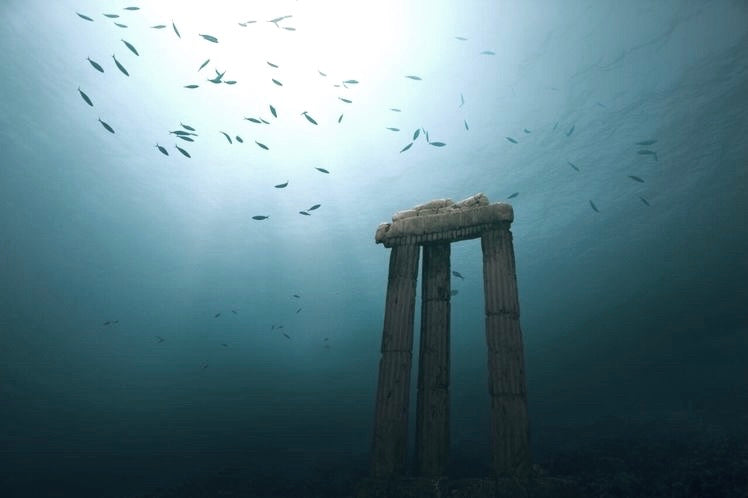From the sunken island of Atlantis to the legendary drowned French city of Ys, our myths and folklore are filled with stories of metropolises swallowed by the sea. But even more fascinating than these questionable submerged cities are the REAL ones that decorate coastlines around the world. These seven underwater cities fill our hearts and minds with mystery, nostalgia, and the wonders of uncovering long lost treasures.
Dive in, Siren..

PAVLOPETRI, GREECE: In 1967, British scientist Nicholas Flemming identified the sunken remains of a city near the islet of Pavlopetri off the south coast of Laconia, Greece and uncovered 15 houses, 37 graves, a tangle of streets, and fragments of pottery. In 2009, a team of archaeologists dated a pottery shard from the site to about 3000 BCE, making Pavlopetri the world’s oldest-known underwater city. The Minoan and Mycenaean people likely occupied the city through the Bronze Age until roughly 1000 BCE, when a series of earthquakes sent the city into the sea.
HERACLEION, EGYPT: French archaeologist Franck Goddio was searching for 18th-century French warships off the coast of Egypt in the Mediterranean Sea when he found something much more spectacular, reports Atlas Obscura. Goddio saw a gargantuan face in the watery depths and realized he had happened upon the lost city of Thonis-Heracleion (the Egyptian and Greek names of the city). The city was once one of the most powerful port cities in the world, controlling all trade coming into Egypt. But after various natural catastrophes, it sunk sometime in the 8th century. Since Goddio's discovery in 2000, 64 ships, 700 anchors, 16-foot statues, gold coins and the remains of a temple to the god Amun have been found among the underwater ruins.
PORT ROYAL, JAMAICA: With a centralized location ideal for trade between Britain and the Caribbean, Port Royal’s population boomed in the late 1600s. In 1662, it had only 740 inhabitants, but by the end of the century the population had jumped to 7,000, half of which were pirates or privateers. With its taverns, brothels, and carousing population, it’s no wonder that Port Royal was often referred to as the wickedest city on Earth. But on June 7, 1692, the hedonism was interrupted when a violent earthquake tore the town apart, sending two-thirds of it underwater and killing 2,000 people. Sickness and injury killed another 3,000 in the quake’s aftermath. The “wicked city” remained a British port, but never regained its unruly reputation.
PHANAGORIA, GREECE (PRESENT DAY RUSSIA):Phanagoria, one of the largest colonies in ancient Greece, was founded circa 540 BCE on the shore of the Black Sea. Its powerful and notorious king, Mithridates VI, ruled Asia Minor (modern-day Turkey) from 119 to 63 BCE. The king and his wife Hypsikratia both had fearsome reputations: he as “Rome’s greatest enemy” and she as a woman with “the spirit of a man.” Mithridates waged three wars on Rome, but he couldn’t fight sea level rise. Centuries later the city’s legacy is preserved underwater. Archaeologist Vladimir Kuznetsov has recovered coins depicting Mithridates and a marble gravestone bearing Hypsikratia’s name.
SHICHENG CITY, CHINA: In 1959, the city of Shicheng (which means "lion city") was intentionally submerged to make room for the construction of a hydroelectric power station. The city was 1,339 years old. The more than 300,000 people who had to be relocated could trace their home back for generations. The well-preserved city with many statues and five entry gates is a time capsule of the period and is open to divers.
DWARKA, INDIA: According to folklore, Dwarka is the home town of Lord Krishna, a placed believed to be an old wives tale, a myth, that is until the ruins were discovered 131 feet below the ocean. The ruins were found beneath the surface of modern-day Dwarka. The complexities and the beauty of this city, has baffled even experts.
BAIAE, ITALY: The luxurious Roman resort town of Baiae, whose thermal springs were first used therapeutically in 176 BCE, was alternately described in literature as either an earthly paradise or a den of iniquity. But while Baiae’s location in a volcanically active region gave it its famous hot springs, it also led to its ruin. In what is called a bradyseismic event, a magma chamber beneath Baiae and the surrounding area gradually drained, causing the land above it to sink. Today, Baiae exists half on land, half in the sea.









Leave a comment